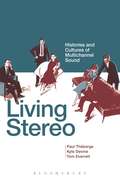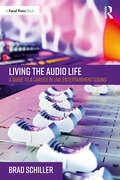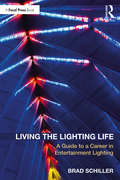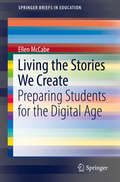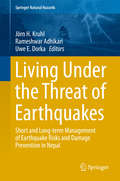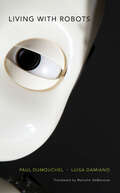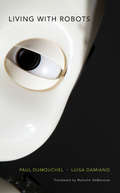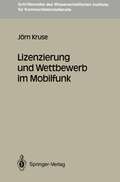- Table View
- List View
Living Rivers: Trends and Challenges in Science and Management (Developments in Hydrobiology #187)
by E. W. R. Leuven A. M. J. Ragas A. J. M. Smits G. Van Der VeldeThis book demonstrates an integrated perspective of trends and challenges in sustainable river science and management, as presented by experts in the fields that form its foundations - ecology, economy and sociology. Their contributions integrate current knowledge of the structure, functioning and management of ‘living rivers’. Also included are data and experiences concerning the rivers Allier, Meuse, Rhine, Sava and Tagliamento in Europe and the Illinois River in the USA.
Living Roofs in Integrated Urban Water Systems
by Daniel Roehr Elizabeth Fassman-BeckWith the infrastructure to manage storm water threats in cities becoming increasingly expensive to build or repair, the design community needs to look at alternative approaches. Living roofs present an opportunity to compliment ground-level storm water control measures, contributing to a holistic, integrated urban water management system. This book offers tools to plan and design living roofs, in the context of effectively mitigating storm water. Quantitative tools for engineering calculations and qualitative discussion of potential influences and interactions of the design team and assembly elements are addressed.
Living Roofs in Integrated Urban Water Systems
by Daniel Roehr Elizabeth Fassman-BeckWith the infrastructure to manage storm water threats in cities becoming increasingly expensive to build or repair, the design community needs to look at alternative approaches. Living roofs present an opportunity to compliment ground-level storm water control measures, contributing to a holistic, integrated urban water management system. This book offers tools to plan and design living roofs, in the context of effectively mitigating storm water. Quantitative tools for engineering calculations and qualitative discussion of potential influences and interactions of the design team and assembly elements are addressed.
The Living Soil: A Lifetime Journey in Understanding It for Human Sustenance (SpringerBriefs in Environmental Science)
by Kodoth Prabhakaran NairThis book will address the importance of the soil management concept, vis-à-vis chemical fertilizer use on soil. Historically, soil testing has been used to quantify bio availability of plant nutrients to field grown crops. However, contemporary soil tests are based on philosophies and procedures developed several decades ago without significant changes in their general approach. For a soil test to be accurate, one needs to clearly understand the physico-chemico-physiologic processes at the soil-plant root interface, and, an understanding of soils and plant root systems as polycationic systems is essential. It is this knowledge that leads to sound prescriptive soil management practices inasmuch as nutrient bioavailability vis-à-vis chemical fertilizers application is concerned, because, of all the factors that govern sustainability of crop production, the nutrient factor is the most important, yet, it is also the least resilient to effective management. The author’s research spanning over three decades in Europe, Africa and Asia, establishes the fact that precise quantification of the nutrient’s “buffer power” holds the key to a clear understanding of the plant bioavailability of some of the most important plant nutrients in crop production, such as, phosphorus, potassium and zinc. “The Nutrient Buffer Power Concept” attempts to clearly explain the bio availability of the three plant nutrients named above on the basis of the diffusion model, as that is the process by which these three important principal plant nutrients are absorbed from the soil by the plant root. Possibly, other plant nutrients which are taken up by the plant roots by the same diffusive model, would also conform to the principles of the concept. A thorough knowledge of thermodynamic principles on the part of the researcher is an absolute pre requisite for this. The book chronicles more than three decades of the professional journey of the author in Europe, Africa and Asia, understanding soil for human sustenance, and developing the revolutionary soil management concept, now globally known as, "The Nutrient Buffer Power Concept" , which has brought the author a string of international recognitions, including the nomination for the "Alternative Nobel Prize" (The Right Livelihood Award),of Sweden, and succour to millions to poor and marginal farmers across Africa, Asia and Latin America.
Living Stereo: Histories and Cultures of Multichannel Sound
by Kyle Devine Paul Théberge Tom EverrettStereo is everywhere. The whole culture and industry of music and sound became organized around the principle of stereophony during the twentieth century. But nothing about this-not the invention or acceptance or ubiquity of stereo-was inevitable. Nor did the aesthetic conventions, technological objects, and listening practices required to make sense of stereo emerge fully formed, out of the blue.This groundbreaking book uncovers the vast amount of work that has been required to make stereo seem natural, and which has been necessary to maintain stereo's place as a dominant mode of sound reproduction for over half a century. The essays contained within this book are thematically grouped under (Audio) Positions, Listening Cultures, and Multichannel Sound and Screen Media; the cumulative effect is to advance research in music, sound, and media studies and to build new bridges between the fields.With contributions from leading scholars across several disciplines, Living Stereo re-tells the history of twentieth-century aural and musical culture through the lens of stereophonic sound.
Living Stereo: Histories and Cultures of Multichannel Sound
by Kyle Devine Paul Théberge Tom EverrettStereo is everywhere. The whole culture and industry of music and sound became organized around the principle of stereophony during the twentieth century. But nothing about this-not the invention or acceptance or ubiquity of stereo-was inevitable. Nor did the aesthetic conventions, technological objects, and listening practices required to make sense of stereo emerge fully formed, out of the blue.This groundbreaking book uncovers the vast amount of work that has been required to make stereo seem natural, and which has been necessary to maintain stereo's place as a dominant mode of sound reproduction for over half a century. The essays contained within this book are thematically grouped under (Audio) Positions, Listening Cultures, and Multichannel Sound and Screen Media; the cumulative effect is to advance research in music, sound, and media studies and to build new bridges between the fields.With contributions from leading scholars across several disciplines, Living Stereo re-tells the history of twentieth-century aural and musical culture through the lens of stereophonic sound.
Living the Audio Life: A Guide to a Career in Live Entertainment Sound
by Brad SchillerLiving the Audio Life details the aspects and procedures necessary for one to have a successful career in live entertainment sound. Encompassing a wide range of topics, the text clearly guides anyone interested in working in a position within the live entertainment audio field. The guide is broken into clearly defined sections, allowing the reader to easily navigate through various subjects including jobs, career, business, creativity, lifestyle, and travel. Real-world examples and documentation from the author and key industry experts allow the reader to gain insight into the essential practices that are helpful throughout a career. Additional in-depth interviews provide details of careers from industry veterans. Whether considering a career in live entertainment audio or just starting out, readers will find the resources for the key to success in audio. Students, those new to sound, and workers already within their careers can refer to the text as a guide throughout their journeys. With benefits to anyone interested in the audio field, Living the Audio Life is a key navigational resource for success.
Living the Audio Life: A Guide to a Career in Live Entertainment Sound
by Brad SchillerLiving the Audio Life details the aspects and procedures necessary for one to have a successful career in live entertainment sound. Encompassing a wide range of topics, the text clearly guides anyone interested in working in a position within the live entertainment audio field. The guide is broken into clearly defined sections, allowing the reader to easily navigate through various subjects including jobs, career, business, creativity, lifestyle, and travel. Real-world examples and documentation from the author and key industry experts allow the reader to gain insight into the essential practices that are helpful throughout a career. Additional in-depth interviews provide details of careers from industry veterans. Whether considering a career in live entertainment audio or just starting out, readers will find the resources for the key to success in audio. Students, those new to sound, and workers already within their careers can refer to the text as a guide throughout their journeys. With benefits to anyone interested in the audio field, Living the Audio Life is a key navigational resource for success.
Living the Lighting Life: A Guide to a Career in Entertainment Lighting
by Brad SchillerLiving the Lighting Life provides practical tools and advice for a successful career in entertainment lighting. This easy-to-navigate guide offers real-world examples and documentation from the author and key industry experts, giving readers a comprehensive overview of the lighting life. The book provides insight on: Different job opportunities in the entertainment lighting industry; Business procedures, contracts, time sheets, and invoices; Tips on self-promotion, networking, and continual learning; The lighting lifestyle, healthy living, and work-related travel; Maintaining and developing creativity to provide innovative lighting and solutions. With insightful interviews from industry veterans, Living the Lighting Life is a key navigational resource for anyone considering a career in entertainment lighting or just starting out.
Living the Lighting Life: A Guide to a Career in Entertainment Lighting
by Brad SchillerLiving the Lighting Life provides practical tools and advice for a successful career in entertainment lighting. This easy-to-navigate guide offers real-world examples and documentation from the author and key industry experts, giving readers a comprehensive overview of the lighting life. The book provides insight on: Different job opportunities in the entertainment lighting industry; Business procedures, contracts, time sheets, and invoices; Tips on self-promotion, networking, and continual learning; The lighting lifestyle, healthy living, and work-related travel; Maintaining and developing creativity to provide innovative lighting and solutions. With insightful interviews from industry veterans, Living the Lighting Life is a key navigational resource for anyone considering a career in entertainment lighting or just starting out.
Living the Stories We Create: Preparing Students for the Digital Age (SpringerBriefs in Education)
by Ellen McCabeThis work explores the potential of digital media to rectify the disparity between formal learning contexts and contemporary perceptions and expectations of narrative. How can education systems respond to the changing technological landscape, thus preparing students to become active participants in society as well as to realise the extent of their own potential? This book explores such concepts in the classroom environment through direct engagement with students and teachers with the case of Shakespeare's Macbeth. Written in approximately 1606, Macbeth has its roots in a culture of orality and yet has sustained through centuries of print dominance. Indeed, as both text and performance the work itself embodies both the literary and the oral. Yet as a staple of many second level curricula increasingly Macbeth is perceived as an educational text. Macbeth reflects its cultural moment, an age of ambiguity where much like today notions of selfhood, privacy, societal structures, media and economy were being called into question. Thus Macbeth can be understood as a microcosm of the challenges existing in contemporary education in both content and form. This book examines Macbeth as a case-study in seeking to explore the implications of digital media for learning, as well as its possible potential to constructively facilitate in realigning formal learning contexts to contemporary experiences of narrative.
Living Under the Threat of Earthquakes: Short and Long-term Management of Earthquake Risks and Damage Prevention in Nepal (Springer Natural Hazards)
by Jörn H. Kruhl Rameshwar Adhikari Uwe E. DorkaThis book addresses earthquakes, with a special focus on the Ghorka earthquake, which struck parts of central Nepal in April 2015. Drawing on this disastrous event, it closely examines various aspects of earthquakes in contributions prepared by international experts. The topics covered include: the geological and geophysical background of seismicity; a detailed inventory of the damage done by the earthquake; effective damage prevention through earthquake-safe buildings and settlements; restoration options for world-heritage buildings; strategies for providing technical and medical relief and, lastly, questions associated with public life and economy in a high-risk seismic zone. Combining perspectives from various fields, the book presents the state of the art in all earthquake-related fields and outlines future approaches to risk identification, damage prevention, and disaster management in all parts of society, administration, and politics in Nepal. Beyond the specific disaster in Nepal, the findings presented here will have broader implications for how societies can best deal with disasters.
Living with Monsters? Social Implications of Algorithmic Phenomena, Hybrid Agency, and the Performativity of Technology: IFIP WG 8.2 Working Conference on the Interaction of Information Systems and the Organization, IS&O 2018, San Francisco, CA, USA, December 11-12, 2018, Proceedings (IFIP Advances in Information and Communication Technology #543)
by Ulrike Schultze Margunn Aanestad Magnus Mähring Carsten Østerlund Kai RiemerThis book constitutes the refereed proceedings of the IFIP WG 8.2 Working Conference on Information Systems and Organizations, IS&O 2018, held in San Francisco, CA, USA, in December 2018.The 11 revised full papers presented together with one short paper and 2 keynote papers were carefully reviewed and selected from 47 submissions. The papers are organized in the following topical sections: setting the stage; social implications of algorithmic phenomena; hybrid agency and the performativity of technology; and living with monsters.
Living with Robots
by Paul DumouchelLiving with Robots recounts a foundational shift in robotics, from artificial intelligence to artificial empathy, and foreshadows an inflection point in human evolution. As robots engage with people in socially meaningful ways, social robotics probes the nature of the human emotions that social robots are designed to emulate.
Living with Robots
by Paul DumouchelLiving with Robots recounts a foundational shift in robotics, from artificial intelligence to artificial empathy, and foreshadows an inflection point in human evolution. As robots engage with people in socially meaningful ways, social robotics probes the nature of the human emotions that social robots are designed to emulate.
Living with the Earth: Concepts in Environmental Health Science
by Gary S. MooreIncludes all the bells and whistles you and your students have come to expect It's hard to imagine a book more innovative and groundbreaking than Living with the Earth: Concepts in Environmental Health Science, Third Edition. The first edition won the CHOICE award for Outstanding Academic Book and both previous editions became bestsellers in their
Living with the Earth, Fourth Edition: Concepts in Environmental Health Science
by Gary S. Moore Kathleen A. BellShelving Guide; Environmental ScienceThis is a groundbreaking and innovative book now in its fourth edition. The first edition won the CHOICE award for outstanding Academic Book while editions two and three became bestsellers on their own right. This fourth edition is packed with new updates on current world events associated with environmental issues and related health concerns. The author maintains traditional concepts and merges them with new and controversial issues. The book has been revised to include up-to-date topics with and a revised Web site with updated links.So what Coverage of emergency preparedness for environmental health practitioners Discussion of population dynamics especially with regard to overpopulation and underpopulation around the world and their respective influences on social, economic, and environmental concerns. The mechanisms of environmental disease, emphasizing genetic disease and its role in developmental disorders and cancer. Human behaviors and pollution are presented along with respect to their roles in cancer risk. The ever increasing issues surrounding emerging and re-emerging diseases around the earth and the introduction of an increasing number of emerging diseases. The growing problems of asthma and other health effects associated with air pollution. An exploration of the mechanisms of toxicity with special reference to the immune system and endocrine disruption. The ongoing issues of the creation and disposal of hazardous waste along with the controversies surrounding disposal are presented. The issues and benefits of recycling are explored. The use of HACCP in assuring food quality, food safety issues, and the Food Quality Protection Act are discussed. Numerous technical illustrations, charts, graphs, and photographs are included What on the Web? Test bank and study questions giving a complete review of the concepts covered. Search tools for online journals and databases covering useful, up-to-date information in health and environmental topics Subject specific links by chapter as well as Federal, state, and organization sites with relevant information Downloadable PowerPoint files for each Chapter providing the instructor with ready-made presentation materials that can be modified as needed. Downloadable and printable test questions and answers for each chapter available to instructors
Living with the Earth, Fourth Edition: Concepts in Environmental Health Science
by Gary S. Moore Kathleen A. BellShelving Guide; Environmental ScienceThis is a groundbreaking and innovative book now in its fourth edition. The first edition won the CHOICE award for outstanding Academic Book while editions two and three became bestsellers on their own right. This fourth edition is packed with new updates on current world events associated with environmental issues and related health concerns. The author maintains traditional concepts and merges them with new and controversial issues. The book has been revised to include up-to-date topics with and a revised Web site with updated links.So what Coverage of emergency preparedness for environmental health practitioners Discussion of population dynamics especially with regard to overpopulation and underpopulation around the world and their respective influences on social, economic, and environmental concerns. The mechanisms of environmental disease, emphasizing genetic disease and its role in developmental disorders and cancer. Human behaviors and pollution are presented along with respect to their roles in cancer risk. The ever increasing issues surrounding emerging and re-emerging diseases around the earth and the introduction of an increasing number of emerging diseases. The growing problems of asthma and other health effects associated with air pollution. An exploration of the mechanisms of toxicity with special reference to the immune system and endocrine disruption. The ongoing issues of the creation and disposal of hazardous waste along with the controversies surrounding disposal are presented. The issues and benefits of recycling are explored. The use of HACCP in assuring food quality, food safety issues, and the Food Quality Protection Act are discussed. Numerous technical illustrations, charts, graphs, and photographs are included What on the Web? Test bank and study questions giving a complete review of the concepts covered. Search tools for online journals and databases covering useful, up-to-date information in health and environmental topics Subject specific links by chapter as well as Federal, state, and organization sites with relevant information Downloadable PowerPoint files for each Chapter providing the instructor with ready-made presentation materials that can be modified as needed. Downloadable and printable test questions and answers for each chapter available to instructors
Living With the Trees of Life: A Practical Guide to Rebooting the Planet through Tropical Agriculture and Putting Farmers First
by Roger LeakeyWith our world torn by climate change, deforestation, land degradation, hunger, malnutrition, poverty, loss of wildlife habitat, zoonotic pandemics, illegal migration and social injustice, this book seeks to find a practical and pragmatic way forwards. Based on the author's extensive experience of tropical agriculture and forestry around the world, as well as his combination of practical and academic agricultural qualifications, the second edition of Living with the Trees of Life presents a unique and positive perspective on resolving these big global issues. It aims to identify principles, strategies, techniques, and skills to find a path through the maze of options for sustainable living in the tropics and subtropics. The book specifically draws heavily on a single case study which involved working to resolve the failure of tropical and subtropical agriculture to feed, sustain and support the needs of rural communities. To address the 'big picture' facing society, the work identified the traditionally important indigenous trees of tropical ecosystems - the trees of life - as a missing component of farming systems. These trees are keystones of the natural environment. Their products and critical ecological and social services have been overlooked by modern agriculture and should be recognized as the natural capital of the environment providing the very many day-to-day needs of local people. Many of today's big problems can be traced back to the breakdown of the natural, social and human capital of farming systems. Hence, a focus on restoring the natural capital also has important benefits for the livelihoods of the rural population, as well as for the productivity of the agroecosystem. However, the real potential is to go much further and to build new natural capital in the form of new socially-modified tree crops producing a very wide range of food, medicinal and other non-food products for new local business enterprises. This then restores the degraded social and human capital and starts to create new physical and financial capitals much needed for employment and economic development. There is, however, a missing 6th capital - the political and social will to change the way we manage our world by re-booting tropical agriculture and putting the needs of local people at the forefront of farming systems. Drawing on the technologies from across the spectrum of current conventional approaches to agricultural production, Living with the Trees of Life seeks to promote the adoption of a new way ahead - described as Land Maxing - that also increases the returns on past investments in agriculture. The target readership of this book is a wide and diverse array of people engaged in advocating and/or adopting ways to address the issues affecting our divided and dysfunctional world, before it is too late. Written in an accessible and engaging style, this book tells the story of how a new area of crop science has emerged across the tropics to create highly nutritious crops which can enhance food security and start to address the big issues facing humanity. Thus, this book is a vital read for academics, policy makers, and the environmentally and socially aware public alike.
Living with the Unexpected: Linking Disaster Recovery to Sustainable Development in Montserrat
by Anja PossekelLiving with the Unexpected deals with complexity and uncertainty, two major challenges in a world faced with climate change and hazards. The study focuses on appropriate methods which enable vulnerable communities to cope effectively with natural hazards and disasters. The central goal of the book is an applicable combination of hazard management and development planning. Therefore, the reconstruction process following a disaster is understood as an opportunity for structural changes and self-organisation processes that foster sustainable development. In this context the potential of scenario planning as an evolutionary and participatory learning approach is addressed. The empirical research concentrates on the time before and during the volcanic crisis on the Caribbean Island Montserrat. Particular methods used are a systematic analysis of the complex system Montserrat, more than 200 interviews with stakeholders and citizens – concentrating on resource and hazard perceptions – as well as the organization and execution of various scenario workshops. The study shows that the opportunity to realise sustainable development on the island with the help of a participative, adaptive reconstruction process is better than ever. The population is sensitised to disasters and an uncertain future. Their preparedness to accept measures which are designed to reduce their vulnerability is high. This book demonstrates how we can learn to live with the Unexpeted.
Living with Transformation: Self-Built Housing in the City of Dhaka (SpringerBriefs in Geography)
by Tareef Hayat KhanThis book describes and analyzes the phenomenon of spontaneous transformation in self-built houses in the context of developing countries. After describing briefly the history of self-built houses and the phenomenon of transformation around the world, it focuses on its context, the city of Dhaka. Firstly it describes the physical patterns of spontaneous transformation. Then it explains the explicit reasons behind those transformations. Finally, it carefully unveils the implicit values that are hidden behind those explicit reasons. The entire book is an ethnographic journey, which not only expresses unique stories of living with transformation, but also captivates the reader throughout with its compelling way of qualitative judgment.
Living with Water: Targeting Quality in a Dynamic World
by Paul Pechan and Gert E. VriesThe factors affecting water quality are many: The increasing buying power and health concerns of the world population contribute to the creation of new products whose production and disposal lead to the release of chemicals harmful to the environment; the ever-growing world population requires a steady food supply, which increases the pressure to use even more chemicals to control various crop pests; and due to climate change, head waters, rivers, and oceans are becoming increasingly warmer, acidic, and eutrophic as the result of carbod dioxide overload. Using specific examples, Water Quality and Resource Management will address the many challenges of providing clean water to the growing world population. It will also discuss the new technologies that are being developed, for example, to treat and reuse waste waters, and the innovative monitoring approaches that help scientists to assess water quality risks. Such risk assessments are urgently needed to help draft legislations and allow enforcement to ensure accessability to quality water for all. The structure of the book will be the following: Each chapter will provide information about a specific water environment and the challenges it faces. This will be followed by discussion of the pollution effects and actions taken to redress the situation. Finally, future trends will be discussed.
Living Without Mathematical Statistics: Accurate Analysis, Diagnosis, and Prognosis Based on the Taguchi Method
by Herbert RueferThe book provides structured access to gaining accurate results of limited data applicable to science, technology, and manufacturing. The Taguchi Method is presented in every detail and also put into practice. The basic principle was developed in the 1950’s. Dr. Genichi Taguchi (1924 to 2012) kept perfecting his method until 2006, and it has been brought up-to-date until now. The main purpose of this book is to make the above knowledge available to a wide range of people of different backgrounds, regardless of their fields of expertise.
Lizenzierung und Wettbewerb im Mobilfunk (Schriftenreihe des Wissenschaftlichen Instituts für Kommunikationsdienste #15)
by Jörn KruseThe Llobregat: The Story of a Polluted Mediterranean River (The Handbook of Environmental Chemistry #21)
by Sergi Sabater, Antoni Ginebreda and Damià BarcelóThe Llobregat belongs to the most thoroughly studied rivers in Europe and is a paradigm of the confluence of human and natural disturbances in a single basin. Because of its location in a very densely populated region and its Mediterranean character, the Llobregat supports a mixture of irregular flow, water abstraction, excess nutrients, mining debris, and a wide array of pollutants. The aquatic organisms strive to survive in a dramatically changing river that passes through a succession of dams, weirs and channels. The long-term river monitoring as well as the research that has been carried out in the river for a long time have provided an extensive knowledge of these disturbances and their effects on the biological communities. This book highlights the available information, with emphasis on the hydrological, chemical and biological elements interspersed in the river. Experts in the field discuss the main nutrient patterns and pollutant occurrence and the responses of the biological quality elements as well as the river ecosystem to the overall natural and man-made influences.



